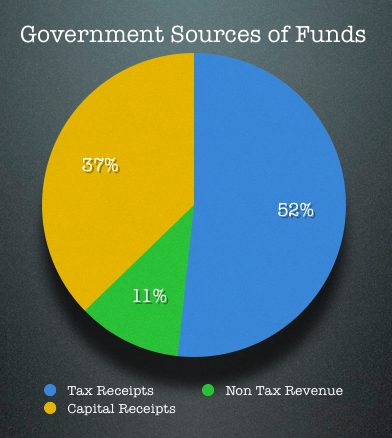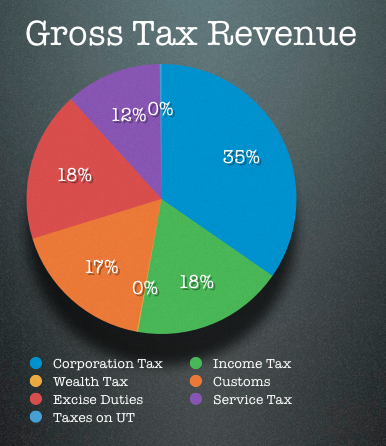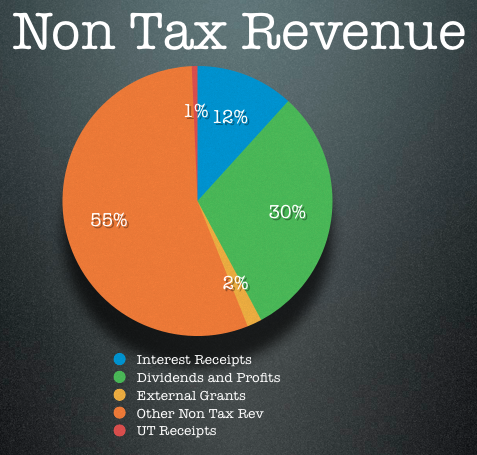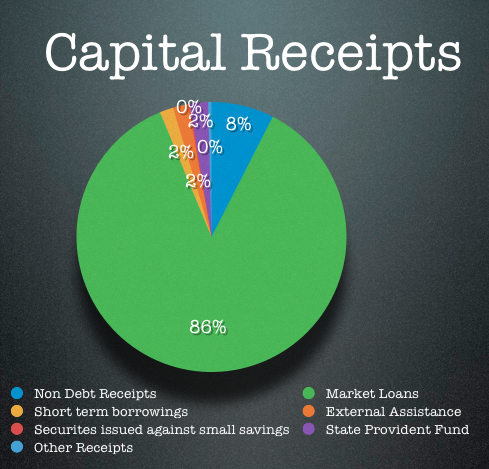Budget 2012: Where does the government get its money from?
I’m going to take a look at the sources of government funds and how they contribute to the government coffers.
First, what are these sources?
1. Revenue Receipts – Tax Revenue: This is the tax that the government collects in the form of corporation tax, personal income tax, customs, excise etc.
2. Non Tax Revenue: These are things like interests on bonds held, dividends from PSUs, and grants. They are revenue sources meaning they don’t have to be repaid and are smaller than tax revenues.
3. Capital Receipts: These are borrowings of the government like the market loans, short term borrowings, external commercial receipts etc.
Now, some charts and the source for the data is the budget website.
First, a pie chart of the top three sources.
Here is the table that shows the absolute numbers.
| Head | In Crore of Rupees |
|---|---|
| Tax Revenue | 7,71,071 |
| Non Tax Revenue | 1,64,614 |
| Capital Receipts | 5,55,241 |
From the above chart, we see that tax revenues are the biggest contributor of money to the government, and now let’s take a look at what the tax revenues comprise of.
Let’s look at the numbers.
| Head | In Crore of Rupees |
|---|---|
| Corporation Tax | 3,73,227 |
| Income Tax | 1,95,786 |
| Wealth Tax | 1,244 |
| Customs | 1,86,694 |
| Excise Duties | 1,94,350 |
| Service Tax | 1,24,000 |
| Taxes on UT | 2,310 |
The striking thing about this chart is perhaps that corporate tax contributes twice as much as individual income tax.
Now, let’s move on to the second head which is the non tax revenues.
First, the chart.
Other tax revenues are dominated by the others column which are things like petroleum royalty and then of course dividends from PSUs come second.
Here are the absolute numbers and remember this is just 11% of the total government funds.
| Head | In Crore of Rupees |
|---|---|
| Interest Receipts | 19,231 |
| Dividends and Profits | 50,153 |
| External Grants | 2,887 |
| Other Non Tax Revenue | 91,207 |
| UT Receipts | 1,136 |
Now, let’s take a look at the last head which is the capital receipts or the government’s credit card.
Here is how that looks like.
Borrowing contains, well, market borrowings and that’s the bulk of this part. Here are the absolute numbers.
| Head | In Crore of Rupees |
|---|---|
| Market Loans | 4,79,000 |
| Short Term Borrowings | 9,000 |
| External Grants | 10,148 |
| Small Savings | 1,198 |
| SPF Net | 12,000 |
| Other Receipts | 2,245 |
A few things that come to my mind looking at the numbers in the form of these pie charts – first, income tax collection is half of corporate tax collection and this when only about 3% of the population pays taxes – surely, the tax base needs to be widened.
Second, a large part of the funds are being raised by borrowing and while it’s good that a large part of this is money raised in INR – the interest payment on this debt eats into the money the government has left to spend on other things and that negatively affects the economy.
Finally, given that subsidies are a large expense for the government it’s hard to really see petroleum royalties as a genuine revenue source, and with crude prices skyrocketing there is an urgent need to rationalize oil subsidies.
What are your thoughts on these charts, do any of these ratios surprise you at all?





Comments
Post a Comment